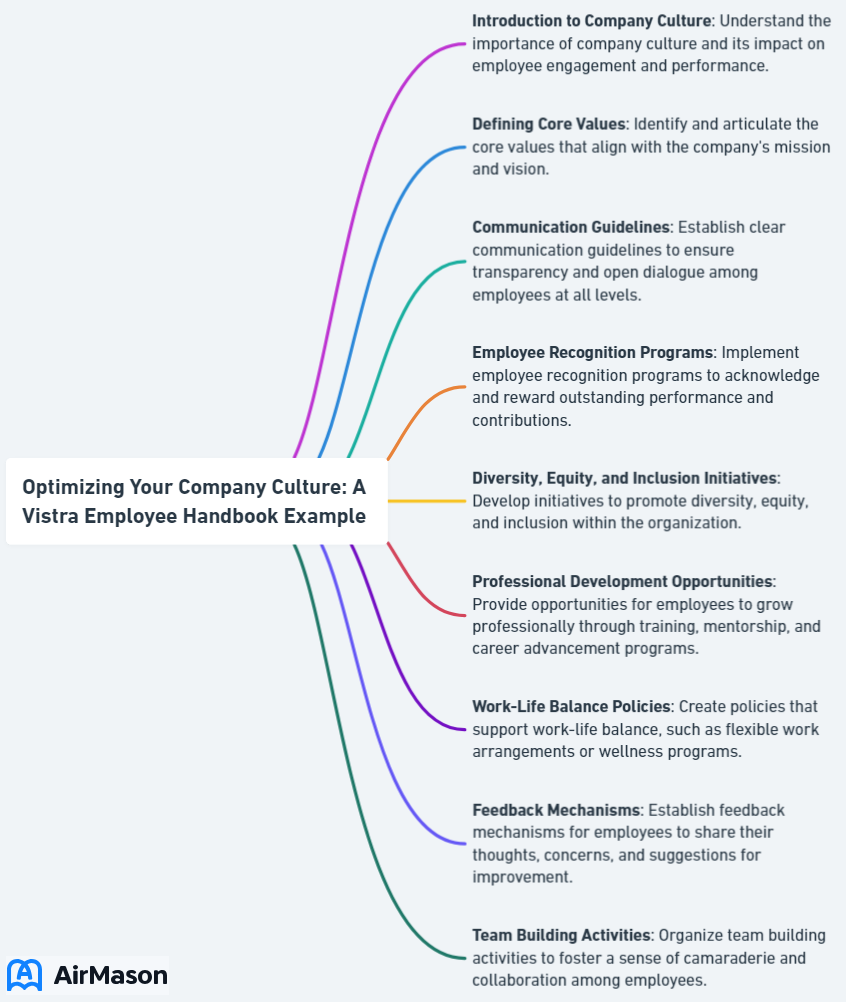
Imagine creating a thriving company culture, seamlessly communicating policies, and providing legal protection – all through a single document. By optimizing your employee handbook, you can accomplish just that. In this blog post, we’ll explore the Vistra Employee Handbook Example and discover valuable insights for creating an effective and engaging handbook tailored to your unique business needs.
Key Takeaways
- Employee handbooks are essential for establishing fair practices, clear expectations and positive relationships.
- They should be used to set the professional tone of company culture by outlining growth, challenges, standards & norms while encouraging employee participation.
- Tips include communicating changes & expectations, providing accessible formats, and encouraging dialogue & feedback from employees.
Fortune 500 Companies Employee Handbook
Welcome to our esteemed Fortune 500 Companies Employee Handbook, a comprehensive guide designed to navigate you through the principles and policies that shape our workplace. In this handbook, “Fortune 500 Companies Employee Handbook” serves as the cornerstone, encapsulating the standards and expectations we uphold. As you embark on your journey within our organization, this document will be your compass, offering insights into our culture, values, and the collective commitment that propels us toward success. Explore the guidelines herein to foster a collaborative and inclusive environment, where every employee contributes to the overall prosperity of our prestigious Fortune 500 company.
Understanding the Importance of an Employee Handbook
An employee handbook serves as a cornerstone for any company. It not only provides employees with clear guidelines, policies, and expectations governing their employment but also fosters fairness, clarity, and consistency in the workplace. By outlining the company’s objectives, leadership styles, and management best practices, handbooks help build a positive management-employee relationship.
Setting the Tone for Company Culture
An employee handbook significantly influences your company’s culture by narrating your company’s growth, explaining how challenges are tackled, and expressing your company’s standards and norms.
Your handbook can also provide employees the opportunity to contribute and take the lead, fostering a sense of belonging and alignment with your company’s mission, a strategy that many employers have found beneficial.

Communicating Policies and Procedures
An employee handbook is your company’s go-to resource for conveying essential information about policies and procedures. It serves as a comprehensive guide for employees, covering everything from short-term disability benefits to leaves and compensation, ensuring they have easy access to the information they need and reducing uncertainty in the workplace.
Legal Protection for Employers and Employees
Having a detailed employee handbook not only sets clear expectations for employees but also provides legal protection for both employers and employees. It establishes explicit expectations and policies, such as anti-discrimination policies, sexual harassment policies, and leave policies, serving as an authoritative document that outlines the rights and responsibilities of both parties.
Key Components of a Vistra Employee Handbook Example

The Vistra Employee Handbook Example showcases essential elements that every employee handbook should encompass, including the company mission, vision, and values, comprehensive employment policies and practices, and the compensation and benefits structure. By adopting these components, you can create a well-rounded handbook that caters to the needs of your employees and your organization.
For your employee handbook to accurately represent your business, understanding industry-specific requisites and your unique company culture and values is imperative. We will examine the key elements of the Vistra Employee Handbook and discuss how they might be adapted to fit your organization. Additionally, the Vistra webchat QR code can be a useful tool for employees to access support and resources.
Company Mission, Vision, and Values
Your company’s mission, vision, and values are the foundation of your employee handbook. They not only offer a comprehensive understanding of your company’s goals but also foster a productive work environment and encourage employee involvement and dedication.
Clearly stating your company’s mission, vision, and values guarantees that your employees are in accord with the goals of companies, thereby boosting the performance of businesses.
Employment Policies and Practices
Incorporating comprehensive employment policies and practices is key to creating a successful employee handbook. These policies provide clear instructions and expectations for employees and ensure uniformity in how the company deals with various employment-related issues, such as:
- Recruitment
- Remuneration
- Benefits
- Performance assessments
- Disciplinary actions
- Termination
Outlining these policies and practices promotes fairness and transparency and ensures adherence to legal requirements, ultimately helping to protect a productive and law-abiding work environment.
Compensation and Benefits
Compensation and benefits are essential components of any employee handbook. By outlining your company’s compensation philosophy, pay structures, and benefits package, you ensure:
- Transparency and fairness
- Vital information to employees
- Protection for your business against claims and lawsuits
- Clear expectations for workplace behavior and responsibilities
Transparency about compensation, social security, and the benefit of offering various paid benefits aids in building trust and loyalty among your employees.
Fluor Employee Handbook Example
In the Fluor Employee Handbook Example, employees gain valuable insights into the company’s policies and guidelines. The Fluor Employee Handbook serves as a comprehensive resource, outlining expectations, benefits, and conduct within the organization. This document provides clarity on workplace protocols, ensuring a harmonious and productive environment. With the Fluor Employee Handbook Example, new hires and existing staff members alike can navigate the intricacies of company procedures, fostering a shared understanding of the organization’s values. By adhering to the guidelines outlined in this handbook, Fluor employees contribute to a positive and cohesive work culture.
Workplace Safety and Security
Addressing workplace safety and security in your employee handbook is crucial for mitigating risk, ensuring compliance with employment laws, and creating a safe and secure work environment for employees. Your handbook should outline policies and procedures that address:
- Physical hazards
- Ergonomic issues
- Cybersecurity threats
- Other potential vulnerabilities
Including these measures in your employee handbook shows your commitment to your employees’ well-being and security.
Customizing Your Employee Handbook to Reflect Your Business
Crafting an employee handbook that genuinely mirrors your business involves adjusting it to fit your particular industry, company culture, and legal obligations. Customizing your handbook guarantees it presents your organization’s unique needs accurately and offers pertinent information to your employees.
We will examine some key strategies for:
- Modifying your employee handbook to meet your industry’s specific needs
- Integrating your company culture and branding
- Maintaining your handbook’s currency with evolving laws and regulations.
Adapting to Industry-Specific Requirements
Adapting your employee handbook to meet your industry’s unique requirements involves understanding the distinct regulations, certifications, or standards pertinent to your industry. It is critical to ensure that your employee handbook accurately reflects these industry-specific requirements to guarantee compliance and provide relevant information to your employees.
Incorporating Company Culture and Branding
Incorporating your company’s culture and branding into your employee handbook can enhance employee engagement and loyalty. By providing a consistent and coherent message that reflects your company’s culture and personality, you help align employees with your company’s:
- Vision
- Mission
- Values
- Tone of voice
This fosters a sense of belonging and connection to your organization, reinforcing your organization’s culture and values.
Updating Handbook as Laws and Regulations Change
Keeping your employee handbook updated is necessary to maintain compliance with shifting laws and regulations. Regular reviews and updates ensure that your handbook:
- Accurately reflects current policies and procedures
- Reduces the likelihood of litigation
- Helps employees stay informed about their rights and obligations
- Guarantees that policies and procedures are clearly communicated to employees.
The Role of Technology in Modern Employee Handbooks

Technology assumes a significant role in modern employee handbooks, augmenting their effectiveness and accessibility through digital formats, HR software integration, and employee engagement. Embracing technological advancements can not only streamline your employee handbook creation process but also improve your employees’ experience and understanding of company policies and procedures.
We will examine the advantages of digital handbooks, the incorporation of HR software and tools, and how technology can stimulate employee feedback and engagement with your employee handbook.
Digital Handbooks and Interactive Features
Digital employee handbooks offer numerous advantages over traditional print versions. They provide easy access to essential information, foster employee responsibility, optimize HR processes, and allow for easier review and consultation. By incorporating interactive features such as search bars, links to other resources, videos, and company timelines, you can create an engaging and interactive learning experience for your employees, enhancing their understanding and involvement with your company’s policies and procedures.
Integrating HR Software and Tools
Incorporating HR software and tools into your employee handbook can simplify access to critical data, automate processes, improve effectiveness, increase employee growth, and optimize resources. Leveraging various HR software, such as employee handbook software, benefits-focused software, recruiting-focused software, performance-focused software, and training-focused software, can streamline the creation, management, and distribution of your employee handbook.
Encouraging Employee Feedback and Engagement
Promoting open dialogue and feedback within your company is essential for enhancing employee engagement and satisfaction. By leveraging technology, such as:
- employee engagement software
- open communication
- collaboration tools
- surveys
- instant feedback tools
You can cultivate a culture of feedback and engagement, ensuring that your employees feel acknowledged and valued by being aware of their needs and contributions.
Moreover, technology can help facilitate employee feedback and engagement with your employee handbook, making it a valuable resource for both employees and management.
Ensuring Compliance with Employment Laws and Regulations

Maintaining compliance with employment laws and regulations is necessary for your employees’ well-being, your organization’s success, and the utility of your employee handbook. By regularly reviewing and updating your handbook, training managers and supervisors on compliance, and seeking professional guidance when needed, you can ensure that your company operates within the parameters of the law, protecting both your business and your employees.
We will discuss the significance of regular reviews, training, and professional advice for an employer in complying with employment laws and regulations.
Regularly Reviewing and Updating Policies
Frequent review and update of your employee handbook is necessary to ensure compliance with laws and regulations and to communicate policies clearly while embodying company culture and values.
Ensuring that your handbook is up to date with the latest laws and regulations can help mitigate potential legal risks for your company. It is recommended to review and update your employee handbook at least once a year.
Training Managers and Supervisors on Compliance
Educating managers and supervisors about compliance with employment laws and regulations is necessary for your company’s success and your employees’ well-being. By providing comprehensive training, you empower managers and supervisors to identify potential issues and red flags, ensure compliance with the law, and create a secure and just work environment.
Seeking Professional Guidance When Needed
Professional advice can play a significant role in keeping your employee handbook compliant with laws and regulations, promoting organizational transparency, and adhering to current best practices. Whether you need legal advice or assistance with policy formulation, seeking professional guidance can help safeguard your company from potential legal issues and ensure that your employee handbook is accurate, up to date, and effective.
Tips for Successfully Implementing Your Employee Handbook

Effectively implementing your employee handbook is vital to its success and the overall prosperity of your organization. By communicating changes and expectations, providing accessible formats for all employees, and encouraging open dialogue and feedback, you can create a valuable resource that empowers your employees, fosters a positive company culture, and ensures compliance with laws and regulations.
We will discuss some practical tips for the successful implementation of your employee handbook.
Communicating Changes and Expectations
Efficient communication of changes and expectations to employees is vital when implementing your employee handbook. Clear communication helps employees understand how to comply with company policies and procedures, reducing potential legal risks.
By holding staff meetings, using various communication methods such as email, intranet, or hardcopies, and providing training and education when necessary, you can successfully communicate changes and expectations for a smooth handbook implementation.
State Street Employee Handbook Example
In the comprehensive State Street Employee Handbook Example, employees gain valuable insights into the company’s policies, procedures, and expectations. This handbook serves as a crucial resource, outlining the rights and responsibilities of individuals within the organization. Through the “State Street Employee Handbook Example,” employees can navigate various aspects of their professional journey, including workplace conduct, benefits, and performance expectations. This document not only fosters a transparent and inclusive work environment but also acts as a guide for fostering a positive and productive workplace culture. Employees are encouraged to familiarize themselves with this handbook to ensure a harmonious and successful collaboration with State Street.
Providing Accessible Formats for All Employees
Making sure your employee handbook is accessible to all employees is necessary for promoting inclusivity and complying with accessibility laws. By offering your handbook in various formats, such as:
- Large print
- Recorded audio
- Electronic format
- Braille
You guarantee that all employees can access and comprehend the content of the handbook, creating a more inclusive and supportive work environment.
Encouraging Open Dialogue and Feedback
Promoting open dialogue and feedback from employees about your handbook can result in enhancements, heightened satisfaction, and a reinforced sense of belonging. By providing employees with a platform to ask questions and give feedback, you demonstrate that their voices are valued, enhancing their engagement and loyalty to your organization.
Summary
In conclusion, optimizing your employee handbook can significantly impact your company culture, policy communication, and legal protection. By incorporating key components such as company mission, vision, and values, employment policies and practices, and compensation and benefits, you can create a valuable resource for your employees and organization. Customizing your handbook to suit your specific industry, company culture, and legal requirements, as well as embracing technology and promoting open dialogue and feedback, will ensure the success of your employee handbook and the overall success of your organization.
Frequently Asked Questions
Is Vistra Energy a good company to work for?
Vistra Energy is a great company to work for, having been ranked #21 on the Best Utilities Companies to Work For in America list. Additionally, Glassdoor reviews from employees rate it 3.8 out of 5 stars.
What is Vistra Corp code of conduct?
Vistra Corp’s Code of Conduct requires a safe and healthy workplace with no discrimination or harassment, promoting diversity and inclusion, and workplace security with respect for human rights.
What are Vistra Energy core values?
Vistra Energy’s core values focus on business ethics, teamwork, competitive success, and commitment to stakeholders.
Is a code of conduct the same as an employee handbook?
The Employee Code of Conduct is an essential part of the Employee Handbook and serves to communicate company expectations to employees. It lays the foundation for the core company values and helps maintain standards.
How often should I review and update my employee handbook?
Review and update your employee handbook at least once a year to stay compliant with laws and regulations, as well as to accurately reflect your company’s policies, procedures, and culture.
Important Disclaimer:
The article presented here does not serve as a representation of the company’s actual employee handbook mentioned in this article.
Our discussions and insights regarding employee handbook are based on assumptions about what may be considered significant in the companies’ policies. These assumptions are drawn from available information and industry knowledge. Readers are advised that the content provided is for informational purposes only and should not be construed as an exact reflection of any company’s official policies or procedures. For precise and accurate details regarding a company’s employee handbook, individuals should refer directly to the company’s official documentation or consult with appropriate representatives.
Please be aware that the content on this page has been generated by using artificial intelligence language models and may contain errors, inconsistencies, or outdated information. It is provided as-is without any warranties or guarantees of accuracy. We strongly recommend using this content as a starting point for further research. We disclaim any liability for damages or losses resulting from the use or reliance on this content.